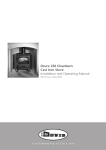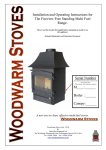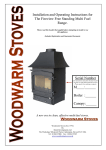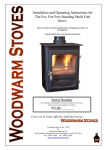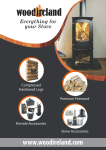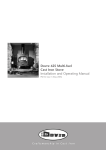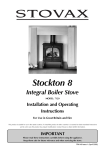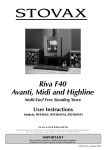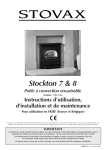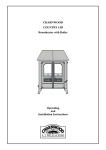Download Dovre 700CBW Manual.qxd
Transcript
Dovre 700 Cleanburn Cast Iron Stove Installation and Operating Manual PM154 Issue 1 (May 2005) Craftsmanship in Cast Iron Dovre 700 Cleanburn Cast Iron Stove Installation and Operating Manual These instructions should be read carefully and saved by the user for future reference. Contents Introduction to you new Dovre 7005: Introduction to your Dovre Stove 2 We would like to thank you for purchasing a Dovre stove and trust that it will provide you with many years of useful service. Unpacking your Dovre 700 3 Getting the best from your Dovre 700 3 Location for Installation 3 Assembly 4 Door Adjustment 4 Installation 5 Operation 5 Cleaning & Maintenance 6 Troubleshooting 6 At Dovre we have been producing cast iron stoves for over 60 years and we strive to ensure that our products meet with the highest level of performance, efficiency, safety and quality. So much so that we guarantee all Dovre body castings for 5 years. Owning a stove might be a new experience for you. Therefore, to ensure that you get the best performance from your new Dovre, do please take a little time to read through this manual. Before commencing with the installation it is important that these instructions are read and fully understood. The DOVRE 700 is a specially designed stove for burning wood only and has been tested and approved by the U.S. Environmental Protection Agency (EPA) in accordance with their stringent woodstove emission limits. It is essential that the wood used is well seasoned (min 2 years) and has a maximum moisture content of 20%. If unseasoned wood is used, heat outputs will not be obtained and serious damage will occur in the chimney and flueways. The DOVRE 700 incorporates a high technology combustion system to provide high efficiencies and low atmospheric pollution The dimensions of your new stove are illustrated in Fig.1. Be careful to ensure that your fireplace is going to accept the appliance and that it complies with current Building Regulations. WE RECOMMEND THAT YOUR DOVRE IS FITTED BY AN EXPERIENCED INSTALLER ACCUSTOMED TO THE INSTALLATION OF SOLID FUEL BURNING APPLIANCES. If you are unsure about any aspect of the installation or operation procedures, your Dovre dealer will be pleased to help. It is important that the installation is carried out in compliance with current Building Regulations. SAFETY Fig 1-STOVE DIMENSIONS Width 710mm Height Depth 705mm 520mm Weight Heat output Flue diameter 180kg 11kW 150mm A fireguard is not provided with this stove. However, it is recommended that one compliant with BS 6539 or BS 6778 is fitted, particularly if the stove is to be used in the presence of young children, the elderly and infirm. 2 Unpacking your Dovre 700 Assembly If your Dovre 700 is finished in enamel, care should be taken to avoid knocks as the enamel surface could “chip”. As the Dovre 700 is constructed from heavy cast iron, it is advisable for two people to assemble and position the appliance. Care should be taken not to break the glass whilst handling the appliance. • Open the stove door and remove all loose parts within. • To assist with lifting, remove the side panels by lifting and disengaging from the bottom and top pins. See Fig 2. Your Dovre 700 is constructed from high-grade quality cast iron and is therefore not light in weight. We recommend that 2 people are available to handle the stove. Before taking your Dovre to its installation location, remove the stove from its outer packing and timber pallet. Stand the stove in the upright position, protecting carpets or other floor coverings with rigid cardboard. The stove carton is ideal for this purpose. Locate the small green quality control slip and retain for future reference. Getting the best from your Dovre 700 Fig 2 There are 3 golden rules to follow • Carefully lift the appliance from the wood pallet, taking care not to slide or tilt the unit, and place in position on the hearth. • Refit the side panels by firstly engaging in the top pins and then positioning on the bottom pins. • For a top flue connection, attach the circular cast iron collar to the aperture located at the top of the appliance, using the nuts, bolts and washers supplied. Use a small amount of fire cement to ensure an air tight seal before fixing. For a rear flue connection, adopt the same procedure using the rear aperture. Fit the cast iron circular cover plate to the unused aperture again using a small amount of fire cement as a seal. The cover plate is attached using the fixing bar and nuts and bolts supplied. See Fig 3. 1. USE GOOD FUEL - NEVER BURN UNSEASONED OR DAMP WOOD 2. YOU MUST HAVE A GOOD CHIMNEY DRAUGHT - NEVER USE YOUR DOVRE STOVE WITH A POOR CHIMNEY 3. AVOID OPERATING THE STOVE FOR LONG PERIODS ON CONTINUOUS LOW TEMPERATURE Location for Installation The location in which your stove is to be installed will of course depend on the chimney available. If you do not have a chimney, there are a number of prefabricated flue systems available and your Dovre Dealer will be pleased to offer guidance on the subject. Building Regulations must be observed when considering the location of your Dovre. More precise information can be found later in this manual but it is important to ensure that a suitable hearth, complying with Building Regulations, is available. NEVER ALLOW A MECHANICAL AIR EXTRACTOR TO BE USED IN THE ROOM OR ADJOINING ROOMS AS THIS COULD CAUSE THE APPLIANCE TO EMIT SMOKE INTO THE ROOM. Fig3 • Fit the front ash lip using the two 8mm x 30mm hex headed bolts supplied. See Fig 4. Fig 4 3 Door Adjustment The door of the Dovre 700 is fully adjustable to ensure air tightness and correct alignment. To make adjustments, use the following procedure. (See Fig 5). Loosen the two hex headed screws located on the right outside front of the firebox. To achieve a tighter door seal, the adjustable hinge plate may be moved forward or backward from the top and/or bottom. Horizontal adjustment can be made firstly by loosening the two hex headed screws on the hinge plate followed by adjusting the set screws. Tightening the top screw will raise the door if it sags and does not latch smoothly. Loosening the top screw will lower the opposite edge if the door is too high. Adjusting both set screws will re-position the door to the left or right for correct alignment. Fig 6 Fig 6a ACCESS FOR SWEEPING CHIMNEY After adjustments have been made, tighten the two hex headed screws on the hinge plate, taking care not to over tighten. The door latch may be adjusted in a similar manner. The chimney should be checked and swept at least once a year and it is important to allow provision for gaining access to the chimney. On masonry chimneys, a standard soot door, obtainable from your Dovre dealer can be used. On other factory made chimneys, it is important to ensure an access cleaning door is provided. It is advisable to ensure that the connecting flue pipe to the chimney has an access door fitted. This will allow access to inside the appliance between the top secondary air distribution unit and top plate. An access door close to the appliance will also facilitate the use of a vacuum cleaner to ensure clean appliance maintenance. (See Fig 6a). THE CHIMNEY The chimney must be in good condition and free from cracks and blockages. If the existing chimney is unlined, it is advisable to install a flue liner suitable for use with solid fuel appliances, with an internal diameter between 175mm (7”) and 200mm (8”). Your Dovre dealer can advise further on this subject. The chimney is responsible for ensuring the flue gases and smoke are taken away from the appliance. IF THE APPLIANCE EMITS SMOKE INTO YOUR ROOM, IT IS NOT THE FAULT OF THE APPLIANCE. THERE WILL EITHER BE A STRUCTURAL OR DESIGN FAULT IN THE CHIMNEY OR A LACK OF VENTILATION IN THE ROOM. Fig 5 Installation If an existing chimney is not available, it is possible to install a pre-fabricated factory chimney system. Your Dovre dealer will provide further information. It is important to ensure that the chimney structure and design comply with Current Building Regulations for solid fuel appliances. HEARTH REQUIREMENT The positioning of the appliance and the size and type of hearth are governed by Building Regulations. The Building Regulations state that the hearth must extend at least 300mm (12”) to the front of the appliance and 15mm (6”) to the sides. If in doubt, expert advice should be sought from your local building inspector. THE MINIMUM DRAUGHT REQUIREMENT FOR THE DOVRE 700CBW IS .06" WATER GAUGE. Too much draught will cause excessive heat outputs and fuel consumption. Inadequate draught may cause smoke emission to the room and poor combustion resulting in a build up of tar and creosote deposits on the glass and inside walls of the appliance and the chimney. CONNECTION TO THE CHIMNEY If an existing masonry chimney is installed, the appliance should be connected to the chimney using 150mm diameter 316 grade 1mm stainless steel or good quality vitreous enamel flue pipe. It is important to ensure that the connection to the chimney is carried out in such a way that any soot or ash is allowed to fall unhindered back into the appliance or flue T- section. (See Fig 6). 4 ADDING FUEL Operation Your wood should ideally be 450mm - 490mm (18”-19”) in length with a diameter of between 50mm and 100mm (2” and 4”). It is good practice, before adding fuel, to separate the ashes from the hot wood embers. To do this, use a fireplace scraper tool to push the ashes to the rear of the stove and pull the hot embers of wood to the front of the stove close to the air inlet. This will help to ensure a faster response with the combustion. The most important factor for avoiding problems with any woodstove is to avoid the formation of tar and creosote build up. Your Dovre 700 incorporates advanced technology and it's design will ensure that, provided it is used correctly and that attention has been paid to the chimney installation, these problems will not occur. IF UNSEASONED WOOD IS USED YOUR APPLIANCE MAY NOT FUNCTION CORRECTLY When adding fuel, load two or three logs of the dimensions given above, close the door and fully open the air control. (See Fig 8). HOW TAR IS FORMED ADJUSTING HEAT OUTPUT A build up of tar within the stove and/or chimney is caused by burning wood at very low temperatures i.e. burnt slowly. The condition is much worse if the wood is not seasoned properly and contains a high moisture content. If the fire is burned at low temperature, the chimney will be cold. Cold chimneys do not work and difficulty occurs with the cold chimney trying to expel the flue gases and smoke. As a result, the gases condense on the walls of the chimney and these gases become creosote or tar.Creosote build up is dangerous and most chimney fires are caused as a result. IT IS ESSENTIAL TO USE WELL SEASONED WOOD AT ALL TIMES. Once the fire has been well established, you can reduce the heat output by pushing the air control lever (Fig 8) to the left. Start by moving the lever about 6mm at a time. With experience, you will soon find the best position most suited to your own installation. The air settings will vary on different installations, depending on the type of wood being used and the draught the chimney is able to produce. During the first few hours of use, your stove may give off an unpleasant odour as the high temperature paint is cured. This is normal, so don't be alarmed as the condition only occurs during the first period of use. LIGHTING THE STOVE ASH REMOVAL Ensure the ash grate is in the closed position (slide to the right) and that the air control lever is in the fully open position. (See Figs 7 & 8). Open the ash grate by sliding to the left. (See Fig 7). Use a fireplace scraper tool to work the desired amount of ash through the grate into the ashpan. When removing ashes from a hot fire bed, try to ensure that some of the hot embers remain in the stove as this will facilitate re-lighting. NEVER LET THE ASHPAN OVERFILL. There should always be a good air space between the top of the ashpan and the underside of the grate. Failure to do this will cause premature deterioration of the grate and will make it difficult to empty the ashpan. To remove the ashpan, open the ashpit door by turning the lever to the left (See Fig 9) and carefully remove the ashpan using the handle provided. Ashes must be disposed of carefully and it is a good idea to purchase an ash carrying box for this purpose. Your Dovre dealer will normally be able to supply a suitable ashpan carrier box. After replacing the empty ashpan in the ashpit compartment, ensure the ashpit door is fully closed by turning the lever to the right. (See Fig 9). Fig 7 Fig 8 Lay a few firelighters (or old newspaper) on the base of the stove. Spread a good quantity of kindling wood, preferably to cover the whole base of the stove. Light the fire and close the door. For the first few minutes, it is advisable not to close the door completely. Leave the door 10mm or 20mm (3⁄8”-3⁄4”) from the fully closed position until the fire is blazing brightly, then close the door fully. It is important to heat up the chimney quickly, to ensure that a good hot fire bed is established before adding further fuel. Fig 9 5 MANAGING YOUR WOOD SUPPLIES Trouble Shooting If you are buying wood from a log merchant, try to ensure that the wood has been seasoned for at least 2 years. 3 years is even better. Store your wood under cover to protect from rain but ideally, the wood should be stored in a place where the wind can be allowed to freely ventilate the stack. SMOKE EMISSION If smoking occurs when the stove door is opened, it is a sign that the flue draught is inadequate. Mostly this condition is caused by burning unseasoned wood and it usually indicates that the combustion temperature is too low. To overcome a weak draught, ensure your wood is dry and build a hot fire, leaving the air control lever in the fully open position. If the problem persists, arrange for your chimney to be expertly checked for design or construction faults. In some instances, down draught conditions will exist and it may be necessary to fit an anti down draught device to the top of the chimney. Try to obtain hardwoods such as oak, elm, beech or ash. These woods will provide more calorific value per cubic metre than softwoods. NEVER BURN COAL, CHEMICALS OR PAINTED WOOD ON YOUR DOVRE 700. FIRE DOESN’T BURN OVERNIGHT Cleaning & Maintenance This is usually caused by either, DOOR GASKETS •WOOD WHICH IS TOO SMALL IN DIAMETER The fibre door gasket around the inside edge of the door provides an air tight seal. Check this regularly and remove any ash or wood particles gently with a soft brush. Replace the gasket once a year. •THE USE OF SOFTWOODS •EXCESSIVE CHIMNEY DRAUGHTS STOVE BODY •DOOR GASKET SEAL WORN OUT To clean, use a soft brush. The stove body can be repainted or touched up using Stovax Thermolac stove paint. Use only hardwood logs approximately 10mm (4”) in diameter and close the air control to the fully closed position. As chimney draughts vary with different installations it will be necessary to experiment with the position of the air control when set for overnight burning. The normal time on a full load of hardwood is approximately 8 hours. GLASS You may notice a build up of deposits on your glass particularly if the stove has been used for long periods at low temperature. A hot brisk fire will normally cure this problem but if the problem persists, check the quality of your wood and/or chimney. It is always recommended to run your stove hard, after an overnight burn. From time to time, the glass can be cleaned using Stovax Glass Cleaner. Never use water or abrasive pads to clean the glass-especially whilst the glass is hot. NOTE: If the appliance is operated for overnight burning, the glass will not stay clean. ANNUAL MAINTENANCE At the end of the heating season, thoroughly clean the inside of the stove and adjoining flue pipe. Arrange for your chimney sweep to inspect and clean the chimney. 6 Five Year Warranty If the castings on this appliance should prove to be defective within five years of the purchase date, the faulty castings will be replaced free of charge, subject to the following conditions: 1) The purchaser shall complete the registration card enclosed and return it within seven days of purchase. Failure to return the registration card could result in delays in processing any claims. 2) The appliance shall have been installed in compliance with the installation instructions and correct Building Regulations. 3) The appliance shall not have been used for the burning of unseasoned wood and/or prohibited fuels. 4) This warranty only applies to the appliance body castings and does not include renewable components including grates, ashpans, and glass, seals, baffle plates and chips on enamel castings. 5) This warranty does not cover site visits and any claims should be notified to your dealer. This warranty does not affect your Statutory Rights. 7 United Kingdom and Eire distributors for Dovre: Stovax Limited, Falcon Road, Sowton Industrial Estate, Exeter, Devon, England, EX2 7LF. Telephone: (01392) 474011 Fax: (01392) 219932 E-mail: [email protected] Internet: www.dovre.co.uk








